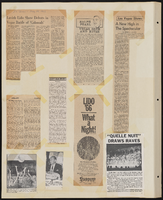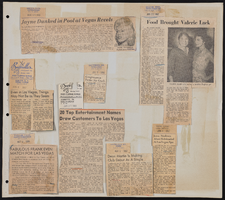Search the Special Collections and Archives Portal
Search Results
Jerry Jackson Papers
Identifier
Abstract
The Jerry Jackson Papers, 1953 to 2009, contain materials related to Jackson's career in entertainment as a director, producer, choreographer, writer, lyricist, and costume designer. Jackson's work on
Archival Collection
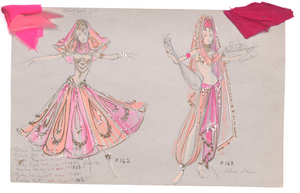
Costume design drawing, two female dancers in pink harem costumes for Pzazz! 68, circa 1967-1969
Date
Archival Collection
Description
Attached to the upper corners of the drawing are different shades of pink fabric swatches for the costumes. Sketches of nudes are on the back.
Costume Details: Two female dancers in pink harem costumes. The performer on the left is dressed in a two-piece costume consisting of a golden, beaded bra and a long, flowing skirt completed with gold detailing and pink and orange hues. She wears a matching headdress and has both arm and writ cuffs. The woman on the right wears a similar costume, except instead of a flowing skirt she is wearing a flowing pair of pants tied with a pink belt around the waist. The outfit is paired with a golden bra, arm and wrist cuffs, and a matching headdress that spans the length of her body.
Show Name: Pzazz! 68
Performance Name: To Bing, Bob and Dorothy "With Love!": Road to Morocco
Image
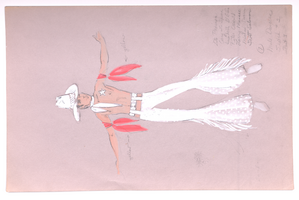
Male dancer in a cowboy costume for Pzazz! 69 at Desert Inn Hotel, Las Vegas, Nevada: costume design drawing
Date
Archival Collection
Description
Hand written on the bottom corner of the image is a list of names and the words: "Male Dancer, Sketch #2, Part 1." The word "yellow" along with an arrow is also written next to each arm scarf.
Costume Details: A male dancer dressed in a cowboy costume. Shirtless, the dancer wears a white star on his chest and has on a white pair of polka dot pants decorated with fringe on the sides. His pants are held up by a white belt positioned high upon his waist. Red scarves are tied around this arms and a patterned white cowboy hat is positioned upon his head.
Show Name: Pzazz! 69
Performance Name: Las Vegas U.S.A. Today: Jazz, Baby, Jazz
Image
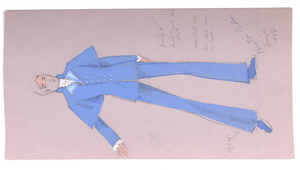
Pzazz! 69 at Desert Inn Hotel, Las Vegas, Nevada, male dancer in blue jumpsuit: costume design drawing
Date
Archival Collection
Description
A costume design drawing of a male dancer in a blue jumpsuit. Across of the peaked lapel jacket are two rows of buttons down that line down the front of the suit, while white ruffles from a dress shirt underneath the jacket peak out around the wrists and collar of the costume.
Costume Details: Hand written along the bottom right of the image: "Jump suit; Jacket w/ center back pleat; Maybe pleat cape; Line cape same or lapels; Christian Cardin; Singer #62." Hand written along the bottom left of the image: "Fly flap."
Show Name: Pzazz! 69
Performance Name: To San Francisco and Love with Music: The Mood- Blue and Beautiful
Image
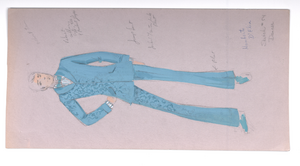
Pzazz! 69 at Desert Inn Hotel, Las Vegas, Nevada, male dancer in a turquoise blue suit: costume design drawing
Date
Archival Collection
Description
Hand written along the right side of the image: "(Illegible) trim; Velvet collar, cuff, tie, and pocket flaps; Jump suit; Jacket with center back pleat; Humberto D'Elia; Sketch #54 Dancer."
Costume Details: Male dancer wearing a turquoise blue jumpsuit that has pleated pants and is decorated with a slightly darker blue cheetah pattern on the left side of the suit. The collar, cuffs, bow tie, and pocket flaps are all made out of velvet. Underneath the suit the dancer wears a blue and white striped dress shirt with a blue bow tie and matching blue shoes.
Show Name: Pzazz! 69
Performance Name: To San Francisco and Love with Music: The Mood- Blue and Beautiful
Image
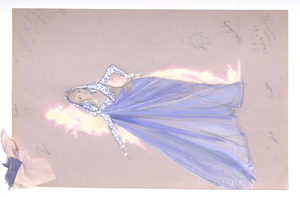
Female dancer in a blue cape/gown for Pzazz! 69, Las Vegas, Nevada: costume design drawing
Date
Archival Collection
Description
A costume design drawing of a female performer dressed in a sparkling blue cape and sheer blue chiffon gown. While the sheer gown drapes across the female's body and slightly hangs behind her, the blue cape of the costume fully covers her arms and acts like a hooded cover for her head. Dangling from her wrists and ears are sparkling silver pieces of costume jewelry.
Costume Details: Light pink and purple fabric swatches of the costume are attached to the upper left corner of the costume drawing. Although there is an abundance of handwritten words along the borders of the image, some of the most legible words lie in the bottom right corner of the image and read: "Kathy Landry; SG- Sketch #81."
Show Name: Pzazz! 69
Performance Name: To San Francisco and Love with Music: The Mood- Blue and Beautiful
Image
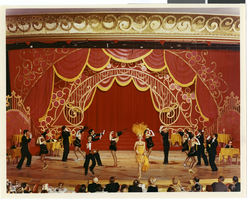
Photograph showing a production of Pzazz! 70 staged by Donn Arden, Desert Inn Hotel, Las Vegas, circa 1970
Date
Archival Collection
Description
Show Name: Pzazz! 70
Performance Name: Chicago: Club Royale
Image

Photograph showing a production of Pzazz! 70 staged by Donn Arden, Desert Inn Hotel, Las Vegas, circa 1970
Date
Archival Collection
Description
Show Name: Pzazz! 70
Performance Name: New York-A Salute to Duke Ellington
Image

